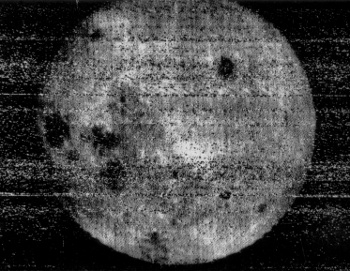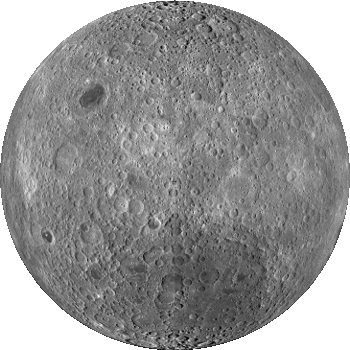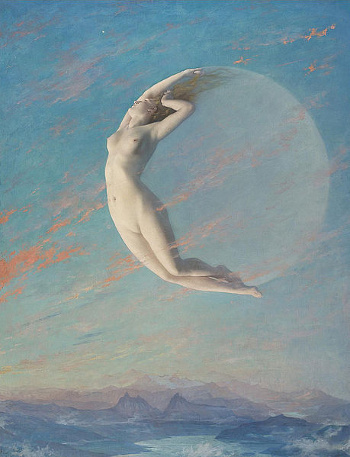The Man in the Moon's Missing Twin
June 27, 2014
Most people, when they hear the term, "far side," think of the popular
Far Side comic strip by
Gary Larson. Larson stopped drawing the Far Side in 1995, but many of the strips are so memorable that they can be found now, twenty years later, in an
Internet search. Of course, none of those images should be there, since these are
copyrighted works. Larson has a web site at
thefarside.com.
There's another "far side," and that's the far side of the
Moon. I wrote about the far side of the Moon in a
previous article (Far Side of the Moon, February 6, 2012). Many people refer to it as the "dark side" of the Moon, since they think that it's always dark, when it actually gets about as much
insolation, on average, as the side that's visible from the
Earth.
The side facing the Earth, however, gets a bit more
light because of
sunlight reflected from the Earth, a phenomenon called
Earthshine. Because of Earthshine, the
New Moon is never perfectly black. The darkness of the New Moon is actually a function of how much
snow and reflecting
clouds the Earth has at a given time.
We only see one side of the Moon, since the Moon is
tidally locked to the Earth. Until 1965, it was thought that the
planet,
Mercury, was tidally locked to the
Sun; instead, it
rotates three times for every two
revolutions around the Sun, so it had appeared to be tidally locked in prior
observations. Because of
libration, a consequence of the slightly
elliptical orbit of the Moon, and
parallax, we can actually observe about 59% of the Moon's
surface from Earth.
Many men have walked on the Moon, but none have walked on the far side. In the early days of
manned spaceflight, such an
expedition would have been
dangerous, since the bulk of the Moon would have blocked
communication with Earth. Today, it's easy to put a
communications satellites at the Moon to solve this problem. Still, we might still use the term, "dark side of the Moon," if by "dark" we mean an unexplored territory.
Until 1959, there wasn't even an image of the Moon's far side. Finally, in October, 1959, the
Soviet spacecraft,
Luna 3,
transmitted low resolution photographs of about 70% of the far side (see image). These images revealed a few large
craters, as could have been expected. However, subsequent
satellite reconnaissance in preparation for
manned landing revealed some major differences between the Moon's near and far sides.

The first image of the far side of the moon, taken on October 7, 1959, by the Soviet Luna 3 spacecraft (North is up in this image).
The Luna 3 images, low resolution though they were, were a sensation when they were published.
(Via NASA Web Site))
The Moon's near side has large, smooth areas, while the far side does not. The smooth areas of the near side are called
maria, from the
Latin word for
sea, since they resemble the
oceans of Earth. The Moon's maria, which cover about a quarter of the near side, are not made of
water; rather, they are remnants of
lava outflows from
volcanic eruptions. Maria are darker than their surroundings because they are
iron-rich. The far side has very little maria coverage (see image, below).

Far side of the Moon.
This NASA Lunar Reconnaissance Orbiter composite image was made from more than 15,000 images acquired between November, 2009, and February, 2011.
(NASA/Goddard/Arizona State University image.)
Now,
astrophysicists from
Pennsylvania State University (University Park, PA) have
published a
theory of why there is a lack of far side maria. They believe that it's because of Earthshine of the hot, early Earth.[1-2] The paper, published in
The Astrophysical Journal Letters, is authored by
Arpita Roy, a
graduate student in
astronomy and astrophysics at Penn State and the lead
author, along with
assistant professor Jason Wright and
professor Steinn Sigurdsson.[1-2]
The far side is nearly devoid of maria because it has a thicker
crust than the near side, and that's a consequence of how the Moon was originally formed.[2] The Moon was formed by the
impact of a
Mars-sized object's hitting the
proto-Earth with a glancing impact, as
conjectured in the
Giant Impact Hypothesis. The outer layers of both the Earth and the striking object were thrown into
space to become the Moon.[2]
The early Moon was about 10-20 times closer to Earth than it is now, and it quickly became tidally locked to have one
hemisphere always facing Earth. The Earth and Moon were both initially
molten, and there was also a
debris disk of
rock,
magma and
vapor around the Earth.[2] The proximity of the hot Earth caused a
thermal gradient that affected the
coalescence of the
material in the disk. Crust-forming
refractory materials were preferentially deposited on the cooler farside, giving rise to its thicker crust.[1]
Earthshine at that time was quite a bit more
energetic at that time, since the
temperature of the Earth was more than 2500
°C. Says study coauthor, Steinn Sigurdsson, "When rock vapor starts to cool, the very first
elements that snow out are
aluminum and
calcium," and these elements are found in high
concentrations in the Moon's crust. These elements would have preferentially
condensed on the cooler, farside of the moon, since the nearside was still too hot. Eventually, these elements
crystallized into
plagioclase feldspars, which migrated to the Moon's surface to form the crust.[2]
Although the Moon is presently
solid throughout, it still had a molten interior during earlier
meteor bombardments. These meteors were able to punch through the crust to release the
lava that formed the maria, but only on the near side. The far side crust was too thick to be penetrated, so the far side
topography has
valleys,
craters and
highlands, but very few maria features.[2] This
research was funded by the
NASA Astrobiology Institute.[2]

Equal time for the Woman of the Moon, Selene, the Moon goddess.
The Roman god, Apollo, is also associated with the Moon, thus the eponymous Apollo Program, successful in landing the first humans on the Moon in July, 1969.
(Oil on canvas painting, 1880, by Albert Aublet (1851-1938), via Wikimedia Commons.)
![]()
References:
- Arpita Roy, Jason T. Wright and Steinn Sigurdsson, "Earthshine on a Young Moon: Explaining the Lunar Farside Highlands," The Astrophysical Journal Letters, vol. 788, no. 2 (June 9, 2014), doi:10.1088/2041-8205/788/2/L42.
- A'ndrea Elyse Messer, "55-year-old dark side of the moon mystery solved," Penn State University Press Release, June 9, 2014.
Permanent Link to this article
Linked Keywords: Far Side; comic strip; Gary Larson; Internet search; copyright; thefarside.com; Moon; insolation; Earth; light; sunlight; reflection; reflected; Earthshine; New Moon; snow; cloud; tidal locking; tidally locked; planet; Mercury; Sun; rotation; rotate; orbit; revolution; observation; libration; elliptical orbit; diurnal parallax; lunar parallax; lithosphere; surface; human spaceflight; manned spaceflight; exploration; expedition; risk; danger; communication; communications satellite; Soviet Union; spacecraft; Luna 3; transmission; transmitted; low resolution; impact crater; satellite imagery; satellite reconnaissance; Apollo program; North; low resolution; maria; Latin; sea; ocean; water; lava; volcanic eruption; iron; NASA; Lunar Reconnaissance Orbiter; composite image; Goddard; Arizona State University; astrophysicist; Pennsylvania State University (University Park, PA); scientific literature; publish; theory; The Astrophysical Journal Letters; Arpita Roy; graduate student; astronomy and astrophysics; author; assistant professor; Jason Wright; professor; Steinn Sigurdsson; crust; impact; Mars; proto-Earth; conjecture; Giant Impact Hypothesis; outer space; hemisphere; molten; debris disk; rock; magma; vapor; temperature gradient; thermal gradient; coalescence; material; refractory material; energetic; temperature; Celsius; °C; chemical element; aluminum; calcium; concentration; condensation; condense; crystal; crystallized; plagioclase; feldspar; solid; meteor; meteorite; bombardment; lava; topography; valley; crater; highland; research; NASA Astrobiology Institute; Apollo Program; Apollo 11; Albert Aublet (1851-1938); Selene; goddess; Greek mythology; Apollo; god; Roman mythology.